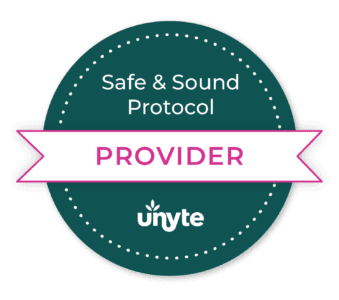Audio Visual Entrainment Therapy
What is Audio Visual Entrainment Therapy?
Audio Visual Entrainment (AVE) Therapy is a non-invasive treatment that uses synchronized light and sound to influence brainwave activity and help regulate the brain’s natural rhythms. In addition to light and sound, AVE therapy includes cranio-electrical stimulation delivered via ear clips, which further enhances the brain’s ability to regulate itself and support cognitive and emotional balance.
During an AVE session, light pulses are delivered through specialized glasses, sound frequencies are played through headphones, and cranio-electrical stimulation is administered via ear clips. This multi-sensory approach engages the brain’s natural patterns, promoting relaxation, mental clarity, enhanced cognitive function, and more.
AVE therapy has been studied for its effectiveness in managing conditions such as ADHD, anxiety, cognitive decline, peak performance, pain management, and traumatic brain injury (TBI) recovery, making it a versatile tool for supporting brain health.
Who Can Benefit from Audio Visual Entrainment Therapy?
AVE therapy can benefit a wide range of individuals, including those dealing with:
- ADHD: AVE has been shown to help regulate brainwave patterns, improving focus, reducing hyperactivity, and enhancing attention span in individuals with ADHD.
- Anxiety and Depression: The synchronized light, sound, and electrical stimulation help regulate brainwave patterns associated with mood, reducing symptoms of anxiety and depression.
- Cognitive Decline and Brain Fog: AVE enhances focus and mental clarity by synchronizing brainwave activity, making it particularly beneficial for individuals experiencing cognitive decline or brain fog, including long COVID recovery.
- Sleep Disorders: For individuals suffering from insomnia or disrupted sleep cycles, AVE therapy helps regulate brainwave patterns that support healthy sleep.
- Pain Management: By stimulating the brain’s natural ability to regulate pain signals, AVE can reduce the perception of pain and improve overall comfort in individuals with chronic pain conditions.
- TBI and Brain Injury Recovery: Research supports the use of AVE therapy in traumatic brain injury (TBI) recovery, as it promotes neural connectivity and improves cognitive recovery.
- Peak Performance: Whether in athletics, academics, or professional settings, AVE helps improve focus, cognitive resilience, and performance, making it useful for those seeking to optimize their mental capabilities.
Benefits of AVE Therapy
AVE therapy offers numerous benefits, depending on individual needs:
- Improved Focus and Attention (ADHD): For individuals with ADHD, AVE helps regulate brainwave activity by promoting more organized and synchronized patterns, resulting in improved focus and attention span.
- Mood Regulation: By influencing brainwave patterns linked to mood regulation, AVE promotes emotional balance, reducing symptoms of anxiety and depression.
- Cognitive Enhancement: AVE synchronizes brainwave activity to enhance memory, attention, and mental sharpness, which is particularly helpful for individuals dealing with cognitive decline or brain fog.
- Better Sleep: AVE can regulate brainwave activity related to sleep, making it effective in managing insomnia and improving sleep quality.
- Pain Reduction: By helping to recalibrate the brain’s processing of pain signals, AVE therapy is effective in reducing chronic pain, including conditions like fibromyalgia.
- TBI Recovery: AVE aids in the recovery from traumatic brain injuries by promoting brainwave synchronization, enhancing neural connectivity, and supporting cognitive improvements.
- Enhanced Peak Performance: AVE is widely used by athletes, executives, and students to optimize mental clarity, focus, and resilience, helping them achieve better performance and productivity).
What to Expect During an AVE Session
In a typical AVE session, you’ll wear specialized glasses that deliver pulses of light while listening to sound frequencies through headphones. Ear clips are used to provide cranio-electrical stimulation, which enhances brain activity. Sessions typically last 20-30 minutes, and the light, sound, and electrical stimulation work together to balance brainwave activity.
Most clients report feeling relaxed during the session, and there’s no downtime required afterward. The multi-sensory approach helps regulate brain activity without causing discomfort.
Course of Treatment for ADHD, Peak Performance, Pain, and More
ADHD: For individuals with ADHD, a course of 10-15 sessions is typically recommended over 6-8 weeks to help balance brainwave patterns, improve focus, and enhance attention.
Peak Performance: High performers often benefit from 8-12 sessions to optimize mental clarity, focus, and cognitive resilience. Athletes, executives, and students use AVE to achieve higher levels of productivity and mental endurance.
Pain Management: For chronic pain, 8-10 sessions of AVE help recalibrate the brain’s perception of pain, offering relief over time.
Cognitive Decline and Brain Fog: Individuals looking to improve cognitive function and reduce brain fog may benefit from 8-12 sessions. Regular use of AVE synchronizes brainwave activity for enhanced focus and clarity.
TBI Recovery: For clients recovering from TBI, 10-15 sessions over a 6-8 week period can support neural repair, improve brain connectivity, and help restore cognitive function.
Is Audio Visual Entrainment Therapy Right for You?
AVE therapy is a safe and effective way to improve cognitive function, manage pain, and support mental and emotional well-being. Whether you’re looking to enhance focus, improve performance, or reduce chronic pain, AVE can provide a powerful, non-invasive approach to support your brain’s natural rhythms.
Contact our intake coordinator today to learn more about how AVE therapy can support your overall well-being.
 (281) 305-9387
(281) 305-9387






